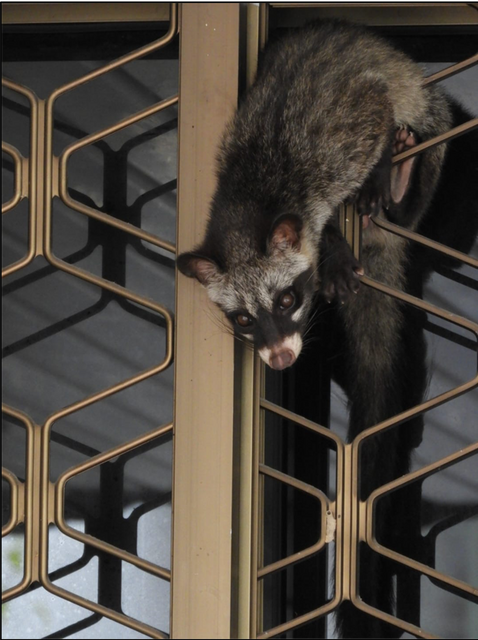
Common Palm Civet
About Common Palm Civets
Raccoon? Badger? No. Civets are omnivorous animals which mainly feed on fruits, and also a variety of insects, small snakes and even birds. These creatures are shy, arboreal and mainly nocturnal, and are rather successful in urban areas. Although they are often called civet cats, civets belong to the family Viverridae and are not cats. With their black-and-white face markings, people sometimes also misidentify them as raccoons or badgers, which are actually not found in Singapore!


Why am I seeing civets in my neighbourhood or in my house?
Common palm civets (Paradoxurus musangus) are well adapted to urban spaces with fruiting trees, and due to their fragmented natural habitats, they are sighted in certain residential areas, which provide suitable food and nesting areas.
At times, civets may use the attic space in the roof/ceiling of a house to nest. This happens due to the availability of gaps for access and the preference for a warm, quiet and sheltered nesting space for the baby civets.
What do I do if I see a civet in an urban area?
It is not uncommon for civets to be sighted in urban areas with greenery, fruiting trees and suitable nesting areas. If you encounter one sleeping during the day or moving about in gardens or urban green spaces, please just appreciate and observe them from a safe distance. If the civet appears to be trapped or injured, please call NParks’ 24-hr Animal Response Centre (1800-476-1600) or ACRES (9783-7782) for assistance.
How can I keep civets out of my roof space or false ceiling?
To prevent civets nesting in your ceiling, you may implement the following methods of exclusion which are humane and long-term:
Identify and block their access routes to the building.
Trim all branches that overhang into your property or over your house.
Wrap external pipes with a smooth and durable surface (such as aluminium or acrylic) for a height of at least 60cm. Such a surface will prevent climbing access as the civet will not be able to get a foothold. However, these wrappings need to be maintained and changed if rusty.
Identify their entry and exit points to the roof and search for any gaps in the false ceiling/attic that serve as a potential entry/exit. Mesh them up to prevent any future visits. However, please ensure that no civets are trapped inside the roof. A good contractor will be able to check that this is done properly.
Civets roost in dark environments so installing lights at potential roosting spots and leaving them switched on at night will discourage them from coming back. Alternatively, motion-sensor lights may also be used depending on the position and number of entry/exit points.
Harvest the fruits from fruiting trees immediately after they have ripened or wrap unripe fruits with a cloth/opaque bag.
Food and shelter are often the reasons for repeated visits and prolonged stays. If the conditions remain suitable for them to nest, removal alone will create a void for another civet to move in. When living conditions are made no longer favourable through the above exclusion measures, the civet(s) will eventually move on to another site.
NParks conducts regular biosurveillance to monitor potential zoonotic threats (including coronavirus) caused by civets, as well as other animals. To date, NParks’ biosurveillance programmes have not detected any transmissible zoonotic diseases in our civets. NParks will continue to closely monitor the local civet population.
Why can’t we just remove the civets by trapping & relocating?
Food and shelter are often the reasons for repeated visits and prolonged stays. If the conditions remain suitable for them to nest, removal alone will create a void for another civet to move in. When living conditions are made no longer favourable through the above exclusion measures, the civet(s) will eventually move on to another site.
If you find a baby civet/s without their mother around, please do not bring them home, even if you have good intentions. Check out this step-by-step guide to assess the situation before getting help!
Did you know?
Rise in demand for civet coffee, also known as kopi luwak, has led to the cruel practice of intensive farming of civets. The farmed civets are force-fed coffee cherries and their faeces are collected to process the coffee beans.
You can help these civets by saying NO to Kopi Luwak!
Learn More
View and download the following advisory on civets, and share it with your friends, family and community!













